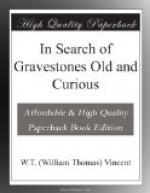In all parts of Scotland at which we find departures from the conventional simplicity of the gravestone, the variation inclines abundantly towards the symbols of trade and husbandry. At Stirling, in the noble churchyard perched on the Castle Rock, the weaver’s shuttle noticed at Inverness appears in many varieties, for Pennant tells us that in 1772 Stirling, with only 4000 inhabitants, was an important factory of “tartanes and shalloons,” and employed about thirty looms in making carpets.[12] Occasionally the bobbin is represented alone, but the predominant fashion is the shuttle open and revealing the bobbin in its place. This is as it appears in No. 1 of the four sketches from Stirling, where it seems to indicate, with the shovel and rake, a mingling of weaver and agriculturist. The other trade emblems speak for themselves, excepting the reversed figure 4 in the stone of 1710 (No. 3). This sign has been variously interpreted, but the most reliable authorities say that it is a merchant’s mark used not only in Stirling but in other parts of Scotland, if not of England. There are in Howff Burial-ground, Dundee, and in many country churchyards round about that town and Stirling, numerous varieties of this figure, some having the “4” in the ordinary unreversed shape, some with and some without the *, some of both shapes resting on the letter “M,” and others independent of any support whatever. It has also been supposed to have some connection with the masons’ marks frequently to be seen in old churches, and is even regarded as possibly of prehistoric origin.[13]
[Footnote 12: Pennant pronounced the view from Stirling heights “the finest in Scotland.”]
[Footnote 13: The vulgar explanation of the sign is “4d. discount on the shilling,” and some of the guide-books are not much better informed when they assume that it marks Stirling as the fourth city of Scotland, for in the old roll of Scottish burghs Stirling stands fifth.]
Fig. 95.—At Blairgowrie.
The stone copied at Blairgowrie is an enigma which I scarcely dare to unravel, but it will admit of several interpretations. “I.E.” probably stands for John Elder and “M.H.” for his “spouse,” but to set out John Elder’s name in full, and at the same time to insert his initials, shews either a misconception of, or disregard for, the principles and usages of the Presbytery. Otherwise, in some respects, this example is almost worthy to be classed with the more degenerate forms of churchyard sculpture in England; the skull, the crown, the hour-glass, the coffin, and the bones being all well-known and conventional signs. The compasses may stand for John Elder’s profession, but the figure which resembles a cheese-cutter, just below the crown, can only be a subject of conjecture. This stone, which is one of the least artistic I have met with in Scotland, is an evidence to shew that the rural sculptor was as ready in the north as in the




